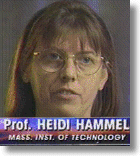
Heidi Hammel - March 6, 1996
Planet Advocate for Neptune

|
"Heidi's Results from Jupiter Occulation" Heidi Hammel - March 6, 1996 Planet Advocate for Neptune |
|
We are exactly one hour from the occultation event. The day crew did a fabulous
job and got the dome cleared of snow and ice. The NSFCAM is dead, but the MIT Camera is
working perfectly. We spent the last seven hours making calibration measurements, doing
set-up work, tests, and simulations, and just generally getting prepared. Slowly
throughout the evening, the winds have been getting stronger and stronger. We just hit
the shut-down limit: sustained winds of 45 mph. The gusts have been hit 70 mph. All we
can do during this last hour is wait, and hope the winds die down enough so that we can
open the dome up again. We are as ready as we can be...
6 March 1996 - 12:40PM Hawaii
Last night, the winds continued to get higher and higher. The telescope operator
waited until the last possible moment, and then opened the dome for us. We went
immediately to Jupiter, which was just rising. Our plan was to take a picture, then
center our camera on the part of the planet where the star was supposed to pop out from
behind the planet. When we took our picture, all of us groaned in disappointment. Instead
of a nice clear picture of Jupiter, all we saw was a big fat fuzzy blur. The general
atmospheric conditions were just poor, probably due to turbulence created by the the very
high winds.
We set up on the planet anyway, and started our instrument running. It was supposed to
focus on a small part of the planet where the star would be, and read out data very very
fast. We were supposed to use the edge of Jupiter to guide the telescope, but because of
the bad seeing, all we could see was blurry fuzziness. We took data anyway, because you
have to take data. When the scheduled time of the event had passed (and we saw nothing
more than blurry patches of light), we stopped the experiment and took a regular picture.
We could see the star - it had popped out right on time. But because we could see the
limb of Jupiter, the telescope had drifted, and we probably did not get useful data. We
were all pretty depressed. But we went ahead and took all our calibration data anyway,
since we may be able to salvage something when we get back to MIT and can take a closer
look.
We finally shut down at 4:45 am, and then spent an hour and half taking our camera off
the telescope and packing it back into the crates. Lots of sighs. We loaded up the truck
and drove down the mountain, talking about how we might have done things differently, and
trying to learn from this unsuccessful experience what we need to do for future events. We
all went to sleep for a few hours, and now we are about to head down the mountain, to the
airport, to begin the long trip back to MIT.
In astronomy, you do everything you can to prepare for your observations, but you can't
do anything about the weather except hope for the best. Sometimes you win, and the
mysteries of the heavens are yours to savor. Other times, the skies hold their secrets
close, and all you can do is imagine what might have been.
|
| Back to Field Journals Menu | Back to Heidi Hammel's Journals | Heidi's Results from Jupiter Occulation 1 |
![]()